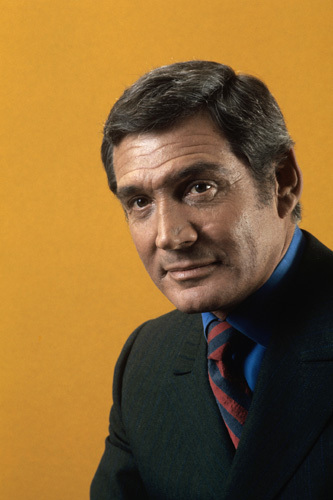Gene Barry
ActorBiografía
With effortless class and elegant charm, Gene Barry took 50s and 60s TV by storm after a rather lackluster start on the musical stage and in films. Born Eugene Klass in New York City on June 14, 1919, the son of Martin, an amateur violinist, and Eva Klass, an amateur singer, he showed a gift at an early age as a violin virtuoso during adolescence (obviously inherited from his father). Attending various public schools, he graduated valedictorian from New Utrecht High School. Possessing a naturally attractive baritone voice, he concentrated on singing after breaking his arm playing football in school ended thoughts of a symphonic career. At age 17 he earned a singing scholarship awarded by David Sarnoff, then head of RCA, to the Chatham Square School of Music and studied there for two years. In the meantime Gene found work in nightclubs, choirs, fairs and emceeing variety shows, and briefly appeared on the vaudeville stage and on radio (winning a prize on Arthur Godfrey’s “Talent Scouts” program). The young actor made it to Braodway in 1942 with the musical “New Moon” in 1942 and went on to appear in the 1944 Mae West vehicle “Catherine Was Great,” where he met and subsequently married chorine Betty Barry, whose stage name at the time was Julie Carson. For the rest of the decade, Gene appeared in a random selection of plays and musicals, which did little to elevate his standing. Hollywood finally beckoned in the 1950s after gaining some notice on the program “Hollywood Screen Test,” and Paramount signed him up. Gene had stoic co-starring roles in such dramatic “B” films as The Atomic City (1952) (his debut movie), Those Redheads from Seattle (1953), and Alaska Seas (1954), none of which capitalized on his singing skills. The one movie in which he did sing, Red Garters (1954), did not fare well with the public. His most recognizable role during this period was as Dr. Clayton Forrester, a scientist who finds himself in the midst of a Martian invasion in the cult sci-fi classic The War of the Worlds (1953). Television became his preferred medium after being offered the title role in Bat Masterson (1958), and he quickly established a very profitable niche as a suave, dapper gentleman in this and other TV productions. Despite the elegant, globe-trotting typecast that befell him, his other TV gents proved just as successful: jet-setting detective Amos Burke in Burke’s Law (1963), for which he won a Golden Globe award, and the impeccably-dressed publishing tycoon Glenn Howard in The Name of the Game (1968). Gene revisited the stage and cabaret venues in the 1970s when his on-camera career hit a lull, appearing frequently with his wife as co-star. The singer/actor made a triumphant return to Broadway in 1983 starring as a gay boulevardier in the musical version of the popular French film La Cage aux Folles (1978), which earned him a Tony nomination. He lost the Tony to his more flamboyant co-star George Hearn. After a year on Broadway, he joined the road company in San Francisco and played Los Angeles for a long stint. Another musicals included “On a Clear Day You Can See Forever,” “Watergate: The Musical” (as Nixon), “Fiddler on the Roof” (with his wife) and “No, No, Nanette”. Gene’s also appeared in his one-man cabaret show entitled “Gene Barry in One” from time to time. In later years he has made only occasional TV and stage appearances (bringing back his famous characters Bat Masterson and Amos Burke, much to the enjoyment of his fans), preferring to indulge in his hobby of painting. He made a very brief return to feature films sharing a cameo scene with one-time co-star Ann Robinson in Steven Spielberg’s epic remake of The War of the Worlds (2005) with both of them playing the Tom Cruise character’s wife’s parents. Also a political activist, his wife Betty died in 2003 after a nearly 60-year marriage. The couple had two sons of their own and adopted a daughter in middle age. Gene himself passed away on December 9, 2009, at age 90.

